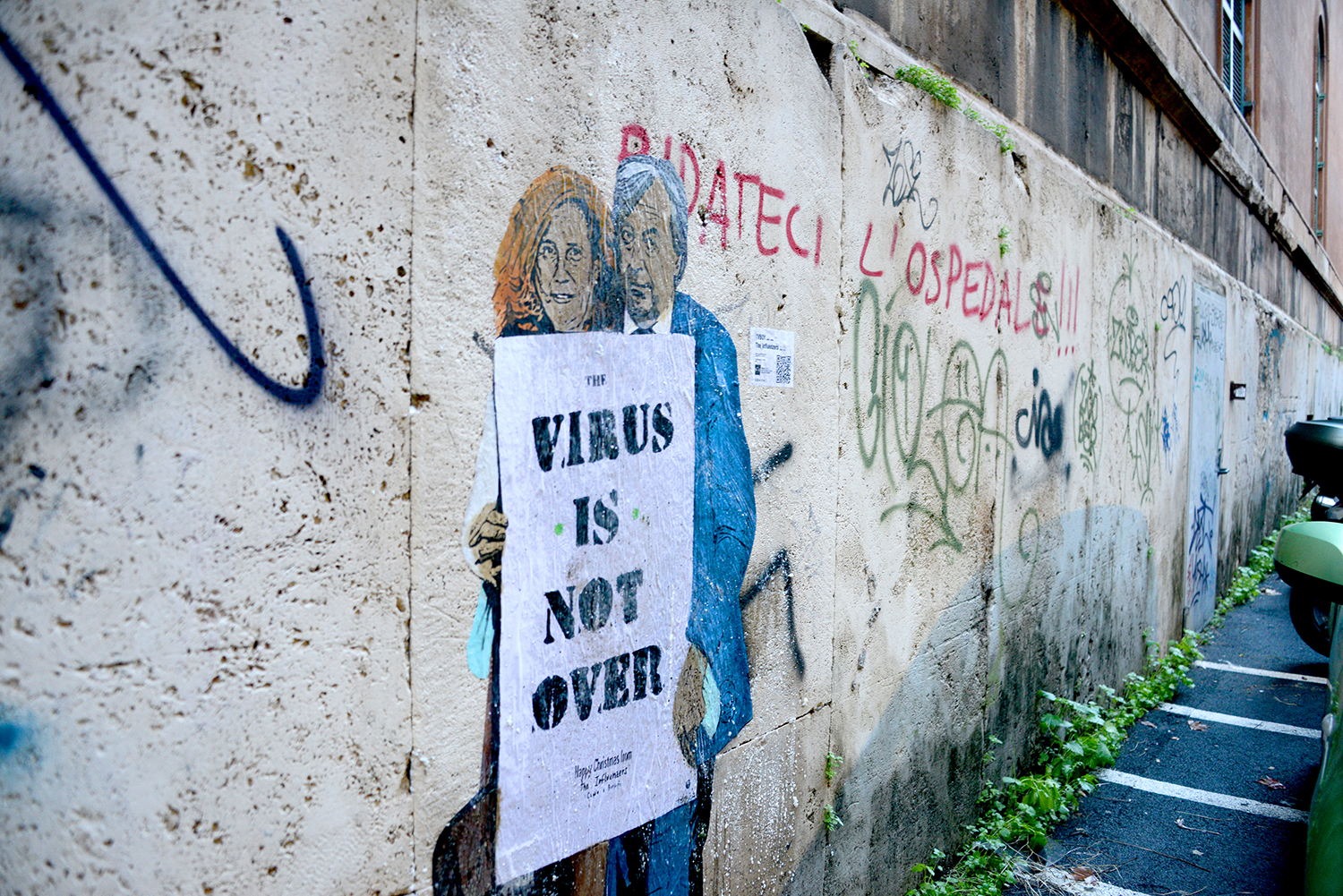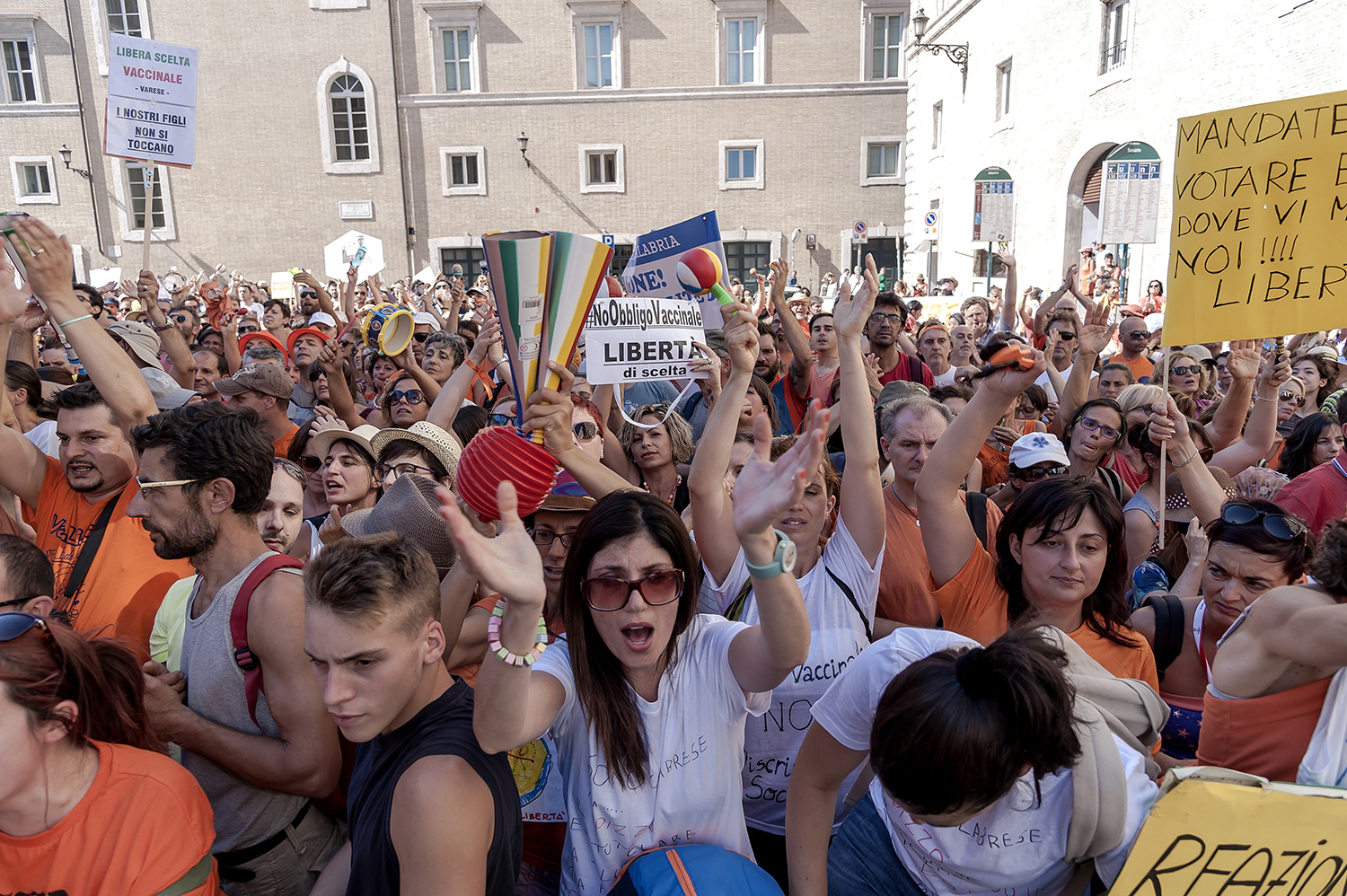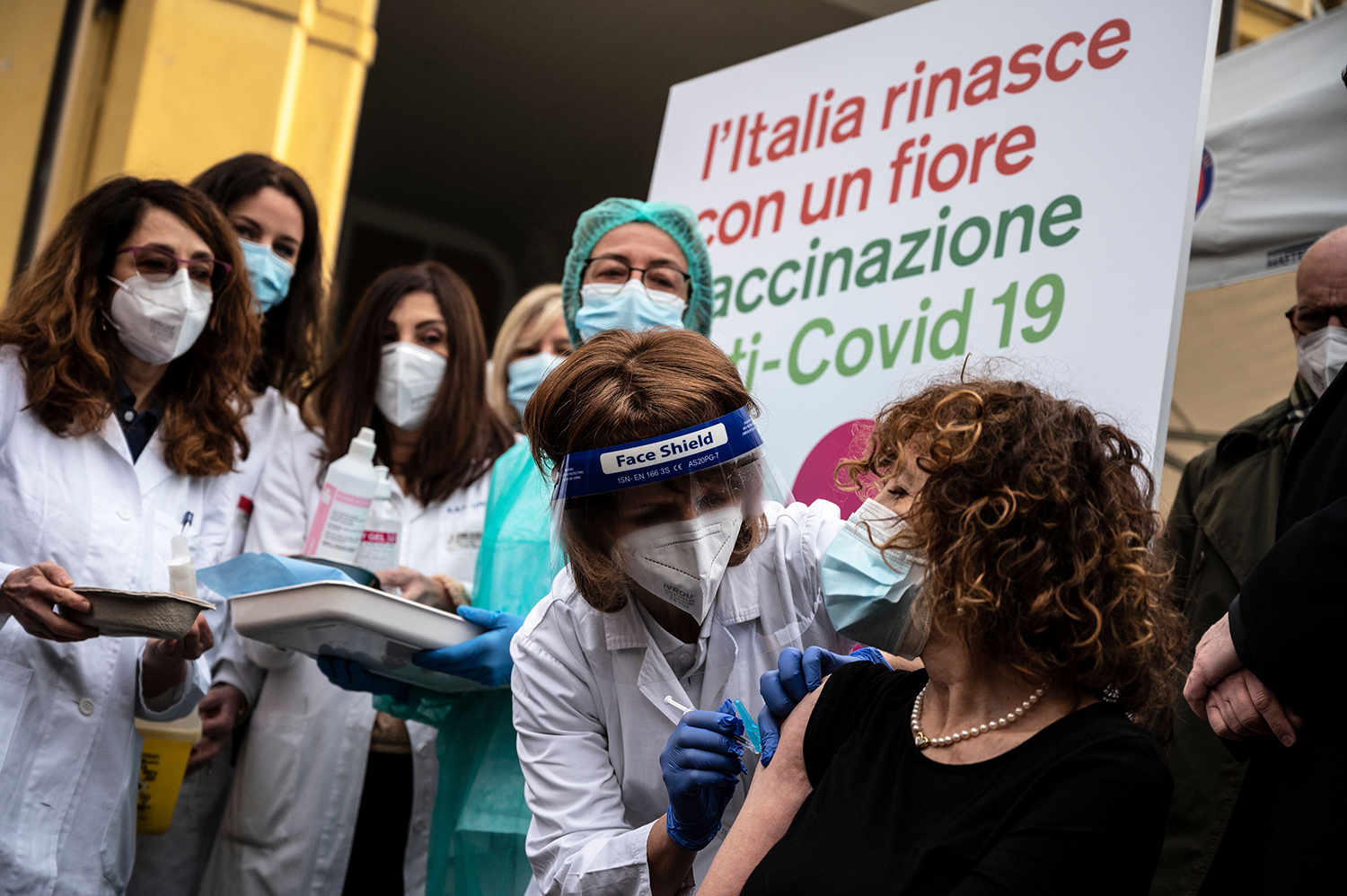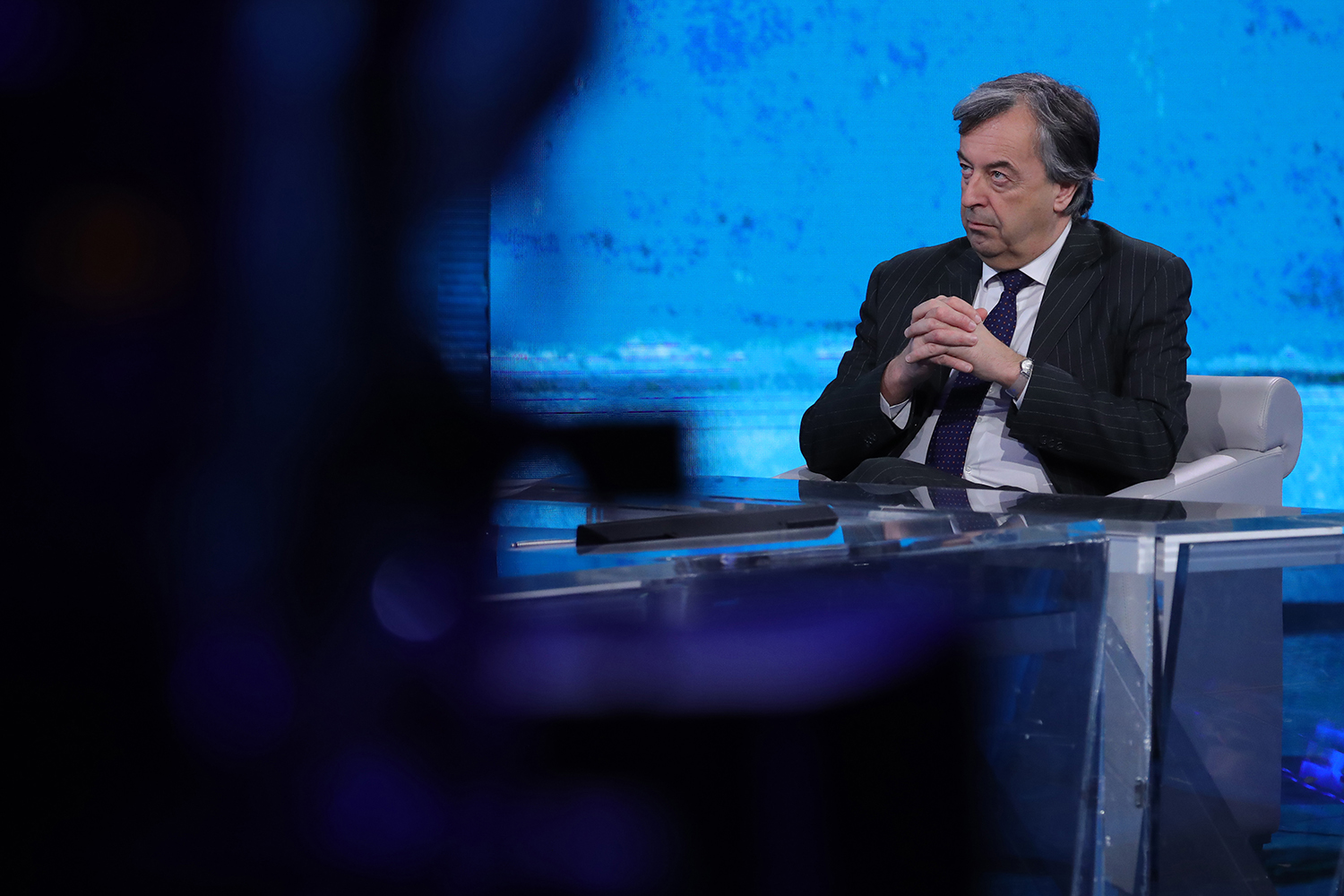Italy’s Crusade Against Antivaxxers Depends on a Doctor Who Talks Like Trump
On Jan. 7, the Italian virologist Roberto Burioni received the first dose of the COVID-19 vaccine and posted a picture of the exciting moment on Facebook and Twitter. “It’s a miracle made by science,” the scientist and media personality commented, reassuring once more his more than 1 million followers on Facebook and Twitter about the safety of the vaccine. To mark the historic occasion, Burioni enabled the replies on his Twitter feed, something he had learned to avoid in order to cut off the throngs of anti-vaxxer trolls who have been pestering him for years.
Soon enough, a tedious refrain began. Some users claimed the picture was doctored and that the shirtless arm didn’t really belong to Burioni. Others noted that the needle was invisible; the syringe looked just too big or too small, suggesting its content was likely not a vaccine, but a regular injection. But filled with what? Only Q knows.
For conspiracy peddlers, the COVID-19 vaccine is the ultimate plot, and the broad range of conspiratorial fantasies includes both the idea the vaccine doesn’t exist at all, and that it’s part of an ominous plan orchestrated by a global elite to control peoples’ bodies.
Burioni shrugged it all off. As an early pro-vaccination crusader, the scientist is used to this kind of aggression. In fact, his vocal squabbles with online armies of denialists are precisely what turned him into a media sensation in the country, a torchbearer of scientific evidence in an environment poisoned by anti-intellectual instincts. Before the word “infodemic” even entered the debate, Burioni was fighting it.
Burioni was also a forerunner of the virologist-pundit type that the coronavirus made famous worldwide. During the first wave of the pandemic, Italians soon became familiar with dozens of scientists constantly commenting on TV and social media about the latest update on the virus, often mimicking the vehement, litigious, and polarizing attitude that makes guests attractive for TV producers and social media managers. While some of them struggled to adapt to the spotlight after having spent most of their careers in a lab, Burioni was in his element.
For Burioni, countering anti-vaxxers became something close to a mission on New Year’s Eve of 2016. That evening, he lost his temper. He was alone in a hospital in Milan, looking after his father, who was battling for his life after a brain hemorrhage. Earlier that day, Burioni had debunked on Facebook a particularly vicious hoax claiming North African immigrants were responsible for meningitis cases reported in Europe. A coalition of far-right xenophobes and anti-vaccine activists trolled him with more lies. The emotionally drained doctor couldn’t bear more anti-scientific nonsense.
Enraged, he erased comments posted to his Facebook page and unintentionally summarized his own philosophy of communication. “This page is not a place where people who don’t know anything can have a ‘civil debate’ with me as if they were my peers. Instead, it’s an account where I, having studied these issues for 35 years, try to explain how things are,” he wrote. His words were meant to put an end to the social media brawl taking place on his Facebook page daily. “Only those who are educated have the right to speak here, not the average citizen. Science is not democratic,” he wrote.
The outburst went viral. Burioni was submerged by likes and extensively quoted in the media. “Science is not democratic” became a maxim widely repeated, and often misinterpreted. What he meant is that scientific evidence does not depend on public opinion or a popular vote. There’s no room for discussion over the speed of light. Others, though, took it as an elitist statement, implying that average people can’t have access to complex truths, which should be simply accepted as secular dogmas proclaimed by scientific authorities.
Currently Burioni has more than 700,000 followers on Facebook; his posts are read daily by several million people, and through a massive TV presence he became a household name in Italy long before the COVID-19 pandemic. With the help of a media-savvy publisher and P.R. expert, he founded the online portal MedicalFacts, devoted to spreading reliable scientific information to the general public. Since the beginning of the pandemic, he has led a segment about the virus on one of the most popular prime-time shows and he edited a series of scientific books published by Corriere della Sera, a leading newspaper. “I proved,” he said proudly, “that it is possible to talk about vaccines in the age of social media.”
Art titled The Influenzers depicts the virologists Roberto Burioni and Ilaria Capua on a wall in Rome on Dec. 3, 2020. Sipa USA via Reuters
A professor of microbiology and virology at the University Vita-Salute San Raffaele in Milan, Burioni spent more than three decades quietly working between labs and university classrooms in Italy and the United States. He was a visiting student in the lab of Hilary Koprowski, the immunologist who demonstrated the first live polio vaccine.
Burioni’s books were instant bestsellers even in the pre-COVID world. Science wrote a glowing profile of Burioni, praising the effectiveness of his communication strategy to counter pseudoscience, a task all the more relevant as the world is dealing with the most extensive vaccination campaign in human history.
How could a 58-year-old virologist with no experience in communication make his voice heard over all the noise? Burioni embraced a particularly brash and direct style, hurling insults at those who touted anti-vaccination nonsense. Often trapped in their own arcane lingo, academics fail to reach the general public, he thought, while other meticulous debunkers of lies had mixed results. Stronger rhetorical medicine was needed.
He started addressing anti-vaxxers and their fellow travelers as “ignoramus,” “cavemen,” “egoists,” “charlatans,” “superstitious,” “suckers,” “fools,” “idiots,” and “dumb.” He bashed on a daily basis “hysterical parents” who spread fearful lies and “failed lawyers” who represented them to make a buck. After being dragged into too many altercations with representatives of the anti-vaccine movement, he declined any interaction. “Respect is due to those who show respect. I don’t owe anything to the idiots who want to teach me virology after Googling for five minutes,” he wrote on Facebook.
The sharp polemicist has the reassuring face of a family doctor in a rural village. His green, downward-slanted eyes, marked by prominent bags, look straight at the camera even in the midst of the most heated debate. He cultivates a strong preference for metaphors. When an interviewer asked him whether the children of anti-vaccine parents should be allowed in schools, he calmly replied: “People who don’t believe in brakes shouldn’t be allowed on highways.”
Burioni’s critics question his verbal aggressiveness. To them, he is a snooty academic who stands on the pulpit of expertise and looks down on the poorly educated masses. He operates in a gray area where the idea of higher knowledge is infused with the temptation of moral superiority.
This pugilistic communication strategy, predicated on a mixture of scientific assuredness and caustic speech, has come to be known in Italy as the Burioni Method. It mimics the self-composed, authoritative posture of Anthony Fauci while drawing from the rhetorical toolbox of former President Donald Trump. It is built on the assumption that the devices of demagoguery can be safely put at the service of good causes. It is designed to win arguments in the highly fragmented, hyperpolarized social media world, which, according to pro-vaccine voices, is almost entirely dominated by anti-vaxxers’ dark conspiracies. The Burioni Method is ultimately constructed on a perversion of Michelle Obama’s paradigm. When they go low, we go lower. Because we are right.
- Demonstrators protest in front of the Italian Senate against a compulsory vaccination policy in Rome on July 18, 2017. Stefano Montesi/Corbis via Getty Images
- Italian senators hold placards depicting Burioni gagged as they protest a vote in the Italian Senate on Aug. 6, 2018. Massimo Di Vita/Archivio Massimo Di Vita/Mondadori Portfolio
Some of Burioni’s rants are iconic. “When I define somebody as an ‘idiot’ it is not an insult; it is a diagnosis that I offer for free,” he once tweeted. He explained that “those who are against vaccines are as dangerous as the Ebola virus.”
The Burioni Method is inextricably intertwined with politics. The professor became a science rockstar during the government of the democratic leader Matteo Renzi, as populist forces were gaining traction on a global scale. The alarming reports on Italy’s immunization trends fostered a perfect storm. The decrease in coverage of 2-year-olds for MMR (measles, mumps and rubella) between 2013 and 2015, and the measles outbreak of 2017 that killed four people, fueled a frenzied debate over the need to expand the number of compulsory vaccines. In the fog of political war, the conflict between scientific reason and obscurantism overlapped with the more nuanced debate over mandatory vaccines.
In June 2017, the Italian government voted on an emergency decree that increased the number of mandatory vaccines from four to 10. Some argued it was unnecessary and disproportionate to the actual public health threats the country was facing at the time. Others warned about the possible backlash of a decision that could be perceived as authoritarian. The leading scientific review Nature criticized the law adopted in France a few months later (based on the Italian model) arguing that portraying the debate as a binary choice between ignorant populations and scientific reason “promotes an unproductive and sterile controversy.” A few commentators simply noted that the relationship between mandatory vaccination and rates of childhood immunization is unproven, at least in the EU countries.
Burioni vocally supported the decree and he was offered a seat in Parliament by the Democrats. The move would have made him the scientific face of an anti-populist campaign. Burioni declined, a choice that reflected his political savvy. He saw the Democrats’ ship sinking and politely refused to jump on board, retaining both his vantage point as an independent scientist and his informal role of political influencer.
In his 2015 book How Propaganda Works, Yale philosopher Jason Stanley challenged the classic definition of propaganda. He suggested it is not necessarily false or biased and could be applied to noble ends, like expanding the immunization rate. Two basic conditions, though, need to be met in order to justify the recourse to propaganda. First, the degree of the alarm presented to the public needs to be proportionate to the actual threat. Second, propaganda techniques may be employed only if there are no other ways to communicate effectively. Arguably, that is the case of hardcore anti-vaxxers, who do not have rational arguments against vaccines and therefore are mostly untouched by the explanations of scientists. The moral obligation to be reasonable wanes in front of an unreasonable interlocutor.
“The science community made a terrible mistake when it decided to present the impending catastrophe caused by global warming in a cool, scientific way in order not to politicize the issue,” Stanley said, drawing an analogy with the debate on vaccines. The dilemma revolves around the complicated relationship between emotions and rationality: “If you’re not emotional when it’s rational to be emotional, you wrongly convey the idea that being emotional is not rational. If you’re not afraid when a bear enters the room, that’s a big problem.”
The physicist and bestselling author Carlo Rovelli argues that quibbling about Burioni’s sneers is “like wondering whether you should take your hat off when a tank is approaching.” The strategies of his adversaries, guiltily amplified by the media, are so “brutal, disgusting, and criminal” that splitting hairs over his harsh rhetoric is “a bit ridiculous,” said Rovelli.
Medical staff members get vaccinated against COVID-19 at the Amedeo di Savoia Hospital in Turin, Northwestern Italy, on Dec. 27, 2020.MARCO BERTORELLO/AFP via Getty Images
The goal of the Burioni Method is undoubtedly a good one. The scientific evidence overwhelmingly proves both the efficacy and safety of vaccines, which are arguably among the most revolutionary inventions in the history of mankind. The question is the adequacy of the means.
The anti-vaccine movement has been blamed as the sole cause of the decline in measles vaccination in Italy, making the population—and particularly children—vulnerable to deadly outbreaks. Burioni wrote that the 2017 measles outbreak happened “with the decisive help of the parents who don’t vaccinate their kids”; then the Democrats’ Prime Minister Paolo Gentiloni blamed the epidemic on the “spread of anti-scientific theories.”
But how many Italians are actually against vaccines? The most reliable study estimates 0.7 percent of parents are anti-vaccine, lower than the 2 percent average in the EU. In the United States, 1.3 percent of parents did not vaccinate their children in 2015, a figure that includes people who have limited access to health services, and the immunocompromised who can’t be vaccinated.
The trickier task is surveying hesitant parents and evaluating the ability of the anti-vax propaganda to persuade them. In Italy, 15.6 percent of parents are considered vaccine-hesitant, but the vast majority of them agree about the benefits of vaccination. The original research on anti-vaxxers in Italy concluded that the vaccine hesitant population people “could benefit from appropriate communication interventions.” The exact meaning of the word “appropriate” is the problem.
The crucial question about the Burioni Method is: Is it working? The Oxford mathematician Marcus Du Sautoy doesn’t think so. “You don’t tell people they are stupid, because this is only going to alienate them. And once you alienated them, they will likely react against you,” he said.
An author, columnist, and popularizer of mathematics in the United Kingdom, Du Sautoy is the professor for the public understanding of science, a position created in 1995 to advance the communication of science to the general public.
Public Understanding of Science (PUS) was based on what is known as a deficit model: People are skeptical about science because they don’t understand it, and that depends on lack of information. The solution would be to task the scientists with transferring their knowledge to non-scientists, establishing a one-way, vertical relationship. Burioni’s motto “science is not democratic” fits squarely in that framework.
That model largely failed. In several cases, it fueled skepticism, especially on politically sensitive topics like genetically modified organisms or climate change. In 2002, British scientists abandoned a name that had “a condescending ring to it,” in favor of a new one, Public Engagement with Science and Technology (PEST). Despite another unfortunate acronym, the change in substance was significant.
“We scientists have so much belief in the way data and theories tell us how things work, that we don’t understand how other people’s minds work. Our attitude should be, I have an expertise, but I do not regard your position as without value,” Du Sautoy said.
Another hypothesis is known as Cultural Cognition Theory. The idea is that people understand scientific facts and the connected risks in subordination to their cultural preferences. Many conservatives think climate change does not pose substantial risks for the planet, and gun ownership is not connected to an increase in violence, despite all the evidence to the contrary. In a similar way, many liberals believe that consuming marijuana is a healthy choice and hydraulic fracking is an extremely unsafe practice. No data proving the opposite could change their minds.
That’s the essence of what Yale professor of law and psychology Dan Kahan called the paradox of science communication: “Never have human societies known so much about mitigating the dangers they face but agreed so little about what they collectively know.” If the problem is ignorance, one would expect people to change their minds as they come to know more information about a certain topic. The opposite is true. In fact, numeracy and level of education are associated with a greater distrust in evidence that is in tension with one’s own values. Across opposing cultural groups, the most science-comprehending individuals are also the most polarized.
In 2014, Kahan conducted research on perceived risks of vaccination in the United States. The paper confirmed that vaccine critics are very small in number, ideologically insular, and do not share a homogeneous cultural worldview. A revealing discovery came from one of his experiments. The subjects read several op-eds arguing in favor of vaccines, and then were asked to declare their feelings about the practice. One of the articles sneered at “anti-science” people who do not believe in evolution, deny climate change, and believe instead that vaccines cause autism. Kahan and his colleagues noted that subjects who had no prior concern about vaccine safety but were skeptical about evolution and climate change showed signs of polarization after being framed as anti-science. In other words, they joined the anti-vaccine fringe only after being associated with other relevant, yet unrelated, beliefs.
Kahan’s research recommended promoting empirical methods to measure risk perceptions around vaccines. It also suggested that governments “discourage ad-hoc risk communication based on impressionistic or psychometrically invalid alternatives to these methods,” a passage that seems tailored to campaigning scientists like Burioni. Such impressionism may culturally polarize the public and erode trust in vaccination programs.
Instead of Burioni’s brutal style, Kahan suggests publicizing “the persistently high rates of childhood vaccination and high levels of public support for universal immunization in the U.S.,” something that is rarely done in the inflamed political debate. The number of Americans strongly opposing vaccination may be growing, but it is also true that the rates of vaccination have never been higher. Despite the increase in measles cases, in Europe more children are being vaccinated than ever before.
“I worry that some of the rhetoric I hear from scientists and doctors will further alienate vaccine-hesitant parents and convince them that they are right to eschew vaccines,” the science writer Melinda Wenner Moyer said. In 2018 she wrote a much-discussed article in the New York Times.
“Some of the loud pro-vaccine voices I hear are polarizing and patronizing; they’re not going to win the trust of nervous parents. They’re only going to drive them further away,” Wenner Moyer said.
Burioni during a television appearance in Milan, Italy, on March 1, 2020. Stefania D’Alessandro/Getty Images
In matters of the science of science communication, Burioni is admittedly unscientific. “I am not a communicator,” he said, “I simply transposed on Facebook what I do in the classroom, and I wouldn’t know how to do it differently.” For Burioni, social media metrics, airtime and bestselling books at the service of a just, scientifically sound goal are enough to certify the validity of his efforts.
The numbers appear to be on his side. After the alarming drop in 2015, immunization coverage in Italy bounced back in 2016 (89 percent for measles) and in 2017 reached 91.7 percent, above the pre-2013 levels. Still, the effects of his harsh rhetoric need to be considered in the larger context of our time. Across western societies, the social fabric is wearing thin, the space for genuine debate is eroding, trust in institutions and expertise is crumbling, and malice tailored for social media is the lingua franca of the present. The Burioni Method claims to be a response to all that, but it ends up resembling the problems it seeks to address.
Ironically, Burioni fits the populist narrative. Demagogues all over the world tell their followers that the scientists and the experts of all sorts think they are dumb and ignorant, and that’s why they shouldn’t believe them. These people may see in Burioni’s behavior the proof that their anti-elitist leaders are onto something.
“The method used by Burioni is the same used by his enemies, he just happens to be right on that specific issue. I don’t think this approach helps to make peace, which is what our society needs,” said Luca Sofri, editor of the online newspaper Il Post. “Our societies grow through education and punishment. The Burioni Method gives up on education and moves directly to punishment, which is the system used by authoritarian governments and police states.”
Maybe Burioni’s evolution from staid scientist to agitated social media warrior is just the inevitable result of contemporary political debate. In an environment where it seems like the only way to be relevant is being louder and nastier than the adversaries, the champions of virtuous causes can undermine their own good intentions.
“Every means can be used for good or bad goals, it all depends on the conscience of the people using them,” Burioni said, insisting that the strategies of his adversaries can be turned against them. “Social media is extremely powerful and can be used to spread disinformation, as any other media in the past. Goebbels didn’t use telegrams for his propaganda. Today, the battle for truth and science is on social media.”







